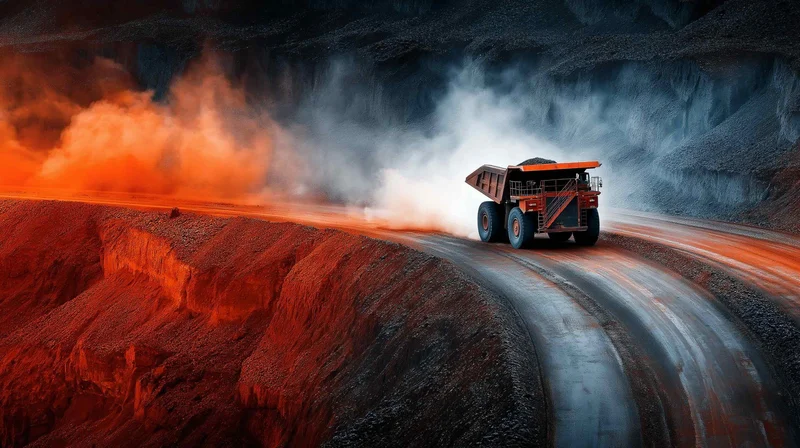Every so often, a signal cuts through the noise of the market. It’s not just a stock ticker flashing green or a sudden spike in trading volume. It’s a tremor, a deep vibration that suggests the tectonic plates of industry and national strategy are shifting beneath our feet. This week, we felt one of those tremors. The company at the epicenter is USA Rare Earth, whose stock didn’t just climb; it launched.
On the surface, this is a story about market speculation. A CEO, Barbara Humpton, mentions being in "close communication" with the White House, and investors, smelling a potential government partnership, rush in. But if that’s all you see, you’re missing the revolution that’s happening in plain sight.
I’ve been watching the resource and materials space for years, often feeling like a geologist pointing at faint fault lines that no one else seemed to care about. But now, the earthquake is here. When I saw the news—reports like Why Shares of USA Rare Earth Are Skyrocketing Today—I honestly just sat back in my chair, speechless for a moment. This isn't just about one mining company. This is the opening act of America's declaration of technological independence.
Let’s back up for a second. What are we even talking about here? "Rare earth elements" is a term that gets thrown around a lot, but it’s poorly understood. These aren’t just shiny rocks; they are the ghost in the machine of modern life. They’re the indispensable, non-negotiable ingredients in everything you care about, from the magnets in your electric vehicle’s motor and the guts of your smartphone to the guidance systems in a fighter jet.
Think of them like the essential vitamins for technology. You only need a tiny pinch of neodymium or terbium in a high-performance magnet, but without it, the entire system collapses. It simply won't work. Now, for decades, we’ve outsourced our entire "vitamin" supply to a handful of countries, creating a geopolitical vulnerability so profound it’s frankly been terrifying. We designed the future, but we left the keys to building it in someone else’s pocket. What happens when they decide not to share?
This is the context you need to understand the USA Rare Earth story. The company isn’t even generating revenue yet. It’s a high-risk venture trying to build a magnet production facility in Oklahoma, essentially from scratch. The speculation that the U.S. government might take an equity stake—much like it did with competitor MP Materials—isn’t just a corporate bailout. It’s a strategic national investment. It’s the government realizing that you can’t lead the 21st century if you don’t control the elements that define it.

So when we talk about a potential partnership, we’re not just talking about a loan or a grant. We’re talking about a foundational decision to reshore the most critical supply chain of the next hundred years. This is about deciding, as a nation, that we will no longer be held hostage by the whims of global supply chains for the materials that power our economy and protect our security. Are we finally waking up to the reality that the future isn’t just coded in Silicon Valley, but also mined from the earth?
This isn't a fluke. It's a pattern. First, the Department of Defense puts a staggering $400 million into MP Materials. Then, a deal with Lithium Americas. Now, the spotlight is on USA Rare Earth. When you connect the dots, the picture that emerges is breathtaking. This is a deliberate, calculated industrial strategy unfolding before our eyes—a modern-day equivalent of the race to the moon.
That might sound like hyperbole, but think about the scale of it. The Apollo Program wasn’t just about putting a man on the moon; it was a national mission that spun off entire industries in computing, materials science, and telecommunications. This move to secure rare earths is a similar foundational play. It’s about building the bedrock upon which future American innovation can stand, and the speed at which this is unfolding is just staggering—it means the gap between our technological ambitions and our material realities is closing faster than we can even comprehend.
This is the kind of breakthrough that reminds me why I got into this field in the first place. For years, we’ve talked about the "what ifs." What if we could build a secure, ethical, domestic supply chain for the building blocks of green energy and advanced defense? Now, we’re moving from the "what if" to the "how."
Of course, there are immense challenges. USA Rare Earth is still a developmental-stage company. The financial risks are real. And more importantly, we carry a profound ethical responsibility. If we’re going to lead this new resource renaissance, we have to do it right. We must pioneer mining and processing technologies that are cleaner, more sustainable, and more ethical than the world has ever seen. We can’t just replicate the old, dirty models; we must invent a new one. This is our chance to set the global standard not just for technological independence, but for environmental stewardship as well.
Imagine a future where the permanent magnets in your EV were made with materials sourced and processed right here in the United States, under the highest environmental standards. Imagine a defense apparatus that is completely insulated from foreign supply chain coercion. That isn't a pipe dream anymore. It’s the mission that’s being funded, right now.
Let's be perfectly clear. The rumblings around USA Rare Earth are about something far bigger than a single company's stock chart. This is the sound of a nation taking control of its own destiny. We are witnessing the painstaking, expensive, and absolutely essential work of building a future where American innovation is powered by American resources. This isn't just a good investment strategy; it's the blueprint for a stronger, more resilient, and truly independent tomorrow.